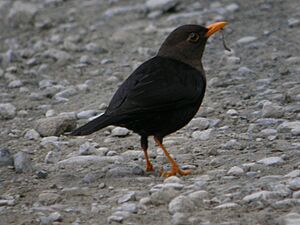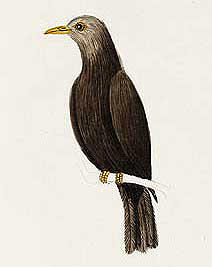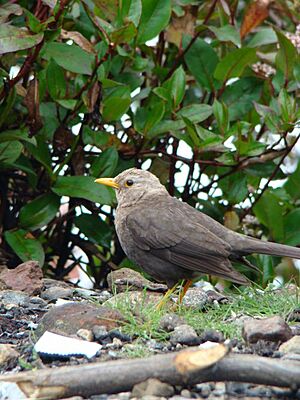Island thrush facts for kids
Quick facts for kids Island thrush |
|
|---|---|
 |
|
| T. p. vitiensis, Fiji | |
| Conservation status | |
| Scientific classification | |
| Genus: |
Turdus
|
| Species: |
poliocephalus
|
| Subspecies | |
|
See text |
|
The island thrush (Turdus poliocephalus) is a common forest bird. It belongs to the thrush family. There are almost 50 different types, called subspecies, of the island thrush. They live across a huge area, from South East Asia to Melanesia and all the way to Samoa. These subspecies look very different from each other, especially their feathers. Sadly, some of these subspecies are threatened (meaning they might disappear), and three types have already become extinct (meaning they are gone forever).
Contents
What is an Island Thrush?
The island thrush is part of a large group of birds called Turdus. This group was named by Carl Linnaeus in 1758. Turdus birds are found almost everywhere in the world!
Scientists find it tricky to sort out all the different types of island thrushes. There are so many subspecies, and they look quite different. It's even thought that there might be two more types of island thrushes that haven't been officially named yet. These are found on the Indonesian island of Sulawesi.
Different Types of Island Thrushes
Here are some of the many subspecies of the island thrush:
- T. p. albifrons (E. P. Ramsay, 1879). Found on Erromango, Vanuatu.
- T. p. becki Mayr, 1941. Found on Paama, Lopevi, Epi and Emae, in Vanuatu.
- T. p. beehleri Ripley, 1977. Found on New Ireland.
- T. p. bougainvillei Mayr, 1941. Found on Bougainville Island.
- T. p. canescens (De Vis, 1894). Found on Goodenough Island.
- T. p. carbonarius Mayr & Gilliard, 1951. Found in the mountains of east-central New Guinea.
- T. p. celebensis (Büttikofer, 1893). Found in south-west Sulawesi.
- T. p. deningeri Stresemann, 1912. Found on Seram.
- T. p. efatensis Mayr, 1941. Found on Efate and Nguna, in Vanuatu.
- T. p. erythropleurus Sharpe, 1887, also called the Christmas thrush. Found on Christmas Island.
- T. p. fumidus Statius Muller, 1844. Found in the mountains of western Java.
- T. p. hades Mayr, 1941. Found on Gau Island, Fiji.
- T. p. heinrothi Rothschild & Hartert, 1924. Found on St Matthias Islands, Papua New Guinea.
- T. p. hygroscopus Stresemann, 1931. Found in southern Sulawesi.
- T. p. indrapurae Robinson & Kloss, 1916. Found in south-central Sumatra.
- T. p. javanicus Horsfield, 1821. Found in the mountains of central Java.
- T. p. katanglad Salomonsen, 1953. Found in central Mindanao, Philippines.
- T. p. kelleri (Mearns, 1905). Found on Mount Apo, Philippines.
- T. p. keysseri Mayr, 1931. Found in the mountains of the Huon Peninsula, New Guinea.
- T. p. kulambangrae Mayr, 1941. Found on Kolombangara, Solomon Islands.
- T. p. layardi (Seebohm, 1891). Found on Viti Levu, Ovalau, Yasawa and Koro Islands, Fiji.
- T. p. loeseri Meyer de Schauensee, 1939. Found in northern Sumatra.
- T. p. malekulae Mayr, 1941. Found on Pentecost, Malekula and Ambrym Islands, Vanuatu.
- T. p. malindangensis (Mearns, 1907). Found on Mount Malindang, Philippines.
- T. p. mareensis E. L. Layard & Tristram, 1879. Found on Maré Island, in the Loyalty Islands, New Caledonia. This subspecies is now extinct.
- T. p. mayonensis (Mearns, 1907). Found in southern Luzon, Philippines.
- T. p. mindorensis Ogilvie-Grant, 1896. Found on Mindoro, Philippines.
- T. p. nigrorum Ogilvie-Grant, 1896. Found on Negros, Philippines.
- T. p. papuensis (De Vis, 1890). Found in the mountains of south-east New Guinea.
- T. p. placens Mayr, 1941. Found on Ureparapara and Vanua Lava, Vanuatu.
- T. p. poliocephalus Latham, 1801, also called the Norfolk thrush. Found on Norfolk Island. This subspecies is now extinct.
- T. p. pritzbueri E. L. Layard, 1878. Found on Lifou, Loyalty Islands, New Caledonia (probably extinct); and Tanna, Vanuatu.
- T. p. rennellianus Mayr, 1931. Found on Rennell Island, southern Solomon Islands.
- T. p. ruficeps (E. P. Ramsay, 1876). Found on Kadavu, Fiji.
- T. p. samoensis Tristram, 1879. Found on Savai'i and Upolu Islands, Samoa.
- T. p. schlegeli P. L. Sclater, 1861. Found in western Timor.
- T. p. seebohmi (Sharpe, 1888), also called the Borneo thrush. Found in the mountains of northern Borneo.
- T. p. sladeni Cain & Galbraith, 1955. Found on Guadalcanal, Solomon Islands.
- T. p. sterlingi Mayr, 1944. Found in eastern Timor.
- T. p. stresemanni M. Bartels Jr, 1938. Found on Mount Lawu, Java.
- T. p. tempesti E. L. Layard, 1876. Found on Taveuni, Fiji.
- T. p. thomassoni (Seebohm, 1894). Found in northern Luzon, Philippines.
- T. p. tolokiwae Diamond, 1989. Found on Tolokiwa Island, Bismarck Archipelago; and possibly New Britain.
- T. p. vanikorensis Quoy & Gaimard, 1830. Found on Vanikolo Islands and Utupua, in the Solomons; and Espiritu Santo and Malo, Vanuatu.
- T. p. versteegi Junge, 1939. Found in the mountains of western New Guinea.
- T. p. vinitinctus (Gould, 1855), also called the Lord Howe thrush. Found on Lord Howe Island. This subspecies is now extinct.
- T. p. vitiensis E. L. Layard, 1876. Found on Vanua Levu, Fiji.
- T. p. whiteheadi (Seebohm, 1893). Found in the mountains of eastern Java.
- T. p. whitneyi Mayr, 1941. Found on Gaua Island, Vanuatu.
- T. p. xanthopus J. R. Forster, 1844. Found on Yandé Island, New Caledonia.
The Taiwan thrush (T. niveiceps) used to be considered a type of island thrush. But newer studies show it's actually its own separate species.
Where Do Island Thrushes Live?
The island thrush lives in many places, but not everywhere in those areas. You can find them on islands in Samoa, Fiji, Vanuatu, New Caledonia, the Solomon Islands, New Guinea and nearby islands, many Indonesian islands, and the Philippines.
However, they only live in places where there aren't too many other bird species (usually less than 25-35 different kinds). On bigger islands like Borneo or New Guinea, this means they only live high up in the mountains, above 2,750 meters (about 9,000 feet). Smaller islands have fewer types of birds, so the island thrush can live at lower heights there.
Sometimes, two or more different subspecies of island thrush can live on the same island. But they will stay in different parts of the island. For example, the T. p. ruficeps subspecies only lives on Kadavu Island in Fiji.
What Do Island Thrushes Look Like?
The 49 subspecies of island thrush look very different from each other. But almost all of them look like a typical thrush bird. They usually have a yellow beak, a yellow ring around their eyes, and yellow legs.
For example, the Samoan subspecies, T. p. samoensis, looks exactly like the blackbird (Turdus merula). On the other hand, T. p. seebohmi from northern Borneo is dark on top with a red chest. It looks a bit like the American robin (Turdus migratorius). Some subspecies even have a completely white head! The Kadavu form, T. p. ruficeps, has a head that is entirely orange.
Island Thrush Behaviour

Diet
The island thrush eats many different things. They eat all sorts of small creatures like insects (mostly beetles), spiders, snails, and earthworms. They also eat dead animals (called carrion) and even small reptiles. They will also eat fruit and seeds, depending on what food is available where they live.
They find their food in a way similar to blackbirds. They search through fallen leaves on the ground and low branches in thick bushes. In some places, they will also look for food high up in the treetops.
Reproduction and Life Cycle
Most island thrushes have a specific breeding season that lasts two to three months. The exact time of year changes depending on where they live. However, the birds in Fiji nest from June until January.
They build a strong, cup-shaped nest that is well hidden in thick plants. They usually lay one to three eggs in their nest.
Conservation Status

Overall, the island thrush species is not in danger. Many of its subspecies are very common in their local areas. However, several subspecies are threatened, and T. p. erythropleurus is considered critically threatened. This subspecies lives on Christmas Island. It is in danger because of introduced yellow crazy ants, which can kill baby birds in their nests.
Several other subspecies are also losing their habitats. This includes T. p. samoensis from Samoa, and T. p. xanthopus from New Caledonia. The T. p. xanthopus is now gone from Grande Terre. Only about 100 of these birds are left, living only on Yande and Neba islands.
Three subspecies of the island thrush have already become extinct:
- The T. p. vinitinctus from Lord Howe Island.
- The T. p. mareensis from the Loyalty Islands.
- The T. p. poliocephalus from Norfolk Island.
The T. p. poliocephalus was quite common in 1941. But by 1975, it had disappeared completely. This happened because of black rats that were brought to the island, loss of their natural home, and mixing with the common blackbird which moved into their area.






